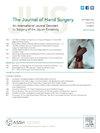健康个体前臂对称的影像学比较及其在尺桡纵向分离诊断中的重要性。
IF 2.1
2区 医学
Q2 ORTHOPEDICS
引用次数: 0
摘要
目的:尺桡纵离离(LRD)是一种经常被遗漏的损伤。最近的一项研究检查了尸体的x线筛查试验,显示骨间韧带(IOL)分离时骨间距离增加。为了使这项测试在临床上有用,必须在未受伤的前臂有类似的骨间间隙。本研究的目的是确定健康人左右骨间隙的典型差异。方法:对28例无外伤史的住院医师进行最大旋后双侧前臂前后位x线片检查。这些图像被上传到图片存档和通信系统,然后进行数字化。测量半径长度(Xr)。测量桡骨与尺骨之间的最大骨间距离(Dmax)以及距离远端尺桡关节0.3 Xr处的骨间距离。比较右臂和左臂距离。此外,还采用离群分析来评估左臂和右臂之间的前臂旋转不对称。结果:异常值分析显示,由于手臂位置不对称,两组前臂x线旋转与其他组不同;这些资料被排除在分析之外。右臂和左臂之间的Dmax平均差异为1.7 mm(标准差[SD] 1.5),平均位置为0.28 Xr。在0.3 Xr固定位置测量的骨间距离差为1.6 mm (SD 1.5)。配对的右臂和左臂之间的Dmax或0.3 Xr没有显着差异。结论:健康人左右臂最大骨间距离无明显差异。因此,分析双侧前臂x线可能是一种简单的LRD筛查试验。临床意义:了解前臂骨间距的正常变化程度可能有助于评估由LRD引起的前臂骨对齐异常。本文章由计算机程序翻译,如有差异,请以英文原文为准。
Radiographic Comparison of Forearm Symmetry in Healthy Individuals and Its Importance in the Diagnosis of Longitudinal Radioulnar Dissociation
Purpose
Longitudinal radioulnar dissociation (LRD) is an injury often missed upon initial presentation. A recent study examined a radiographic screening test in cadavers that showed increased interosseous distance when the interosseous ligament (IOL) was divided. For this test to be clinically useful, it is necessary for uninjured forearms to have similar interosseous spaces. The purpose of this study was to determine the typical differences between right and left interosseous spaces of healthy individuals.
Methods
Anterior-posterior x-rays of bilateral forearms in maximum supination of 28 surgical residents with no history of injury were obtained. These images were uploaded into a picture archiving and communication system and then digitized. The length of the radius was measured (Xr). The maximum interosseous distance (Dmax) between the radius and ulna as well as the interosseous distance at a location 0.3 Xr from the distal radioulnar joint was measured. The right and left arm distances were compared. Also, an outlier analysis was used to evaluate forearm rotational asymmetry between right and left arms.
Results
The outlier analysis revealed two sets of forearm x-rays were rotationally different compared to the rest of the group due to asymmetric arm positioning; these data were excluded from the analysis. The average difference in Dmax was 1.7 mm (standard deviation [SD] 1.5) between right and left arms, and this was found at a position of 0.28 Xr on average. The difference in interosseous distance measured at a fixed location 0.3 Xr was 1.6 mm (SD 1.5). No significant difference was found between the paired right and left arms for Dmax or at 0.3 Xr.
Conclusions
There does not appear to be any significant difference between the maximum interosseous distance of right and left arms in healthy individuals. Therefore, analyzing bilateral forearm x-rays may be a simple LRD screening test.
Clinical relevance
Understanding the degree of normal variation in the forearm bone spacing might inform evaluation of abnormal forearm bone alignment resulting from LRD.
求助全文
通过发布文献求助,成功后即可免费获取论文全文。
去求助
来源期刊
CiteScore
3.20
自引率
10.50%
发文量
402
审稿时长
12 weeks
期刊介绍:
The Journal of Hand Surgery publishes original, peer-reviewed articles related to the pathophysiology, diagnosis, and treatment of diseases and conditions of the upper extremity; these include both clinical and basic science studies, along with case reports. Special features include Review Articles (including Current Concepts and The Hand Surgery Landscape), Reviews of Books and Media, and Letters to the Editor.

 求助内容:
求助内容: 应助结果提醒方式:
应助结果提醒方式:


